I am trying Matrix operations. The data is a time series model - Autoregressive model, AR(2) where the model order p =2 represented by the variable Y excited by white Gaussian noise, epsilon. I am stuck with conceptual questions for which I will be grateful for answers. The code computes the autocorrelation matrix after multiplying the 1 sampled time delayed vector Y with the transpose of the 1 samples time delayed vector. The general formula for correlation is E(Y*Y'). In this case I need to do E(Y(1:end)*Y(1:end)'). The answer is a scalar if done this way. But, based on the reply by Walter Roberts mathematical expectation I am able to get a 9 by 9 matrix. However, I am not getting a non-singular matrix.
How do I create a singular matrix for the autocorrelation matrix such that the inverse can be computed? Please help
THE CODE:
clc;
clear all;
var_eps = 1;
epsilon = sqrt(var_eps)*randn(5000,1); % Gaussian signal exciting the AR model
Y(1) = 0.0;
Y(2) = 0.0;
for n= 3:5000
Y(n)= 0.1950*Y(n-1) -0.9500*Y(n-2)+ epsilon(n); %AR(2) model
end
y_tminus1 = Y(1:end-1).';
mult = y_tminus1*y_tminus1'; %This creates a square matrix
autocorr = xcorr2(mult); %To perform autocorrelation of 1 sampled lag time series with itself(1 sampled lag)
inverse_autocorr = inv(autocorr); **%PROBLEM**
%Warning: Matrix is singular to working precision.
trace_inv=trace(inverse_autocorr);
UPDATE: I am facing this problem since I am trying to implement the terms of the matrix in Expression of Eq(20) and the RHS of Eq(24) 

UPDATE : 01 Dec
In this code, the issues, the analytical form of variables
CRB_LHS = (b_transpose_b/N)*tr(inv(E[y(t-1)y(t-1)']))
CRB_RHS = sigma2_v*tr(inv(sum_t =1 to N E[y(t-1)y(t-1)']))
where y(t-1) =
[y(t-1), y(t-2),..,y(t-p)]'
The CRB_LHS is calculated from Eq(19) of the paper
`Y_ARMA(n)= 0.1950*Y_ARMA(n-1)- 0.1950*Y_ARMA(n-2) + b*x_gauss(n);` where
x_gauss = N(0,1)
The CRB_RHS is calculated from Eq(1)
Y_AR(n) = 0.1950*Y_AR(n-1) -0.9500*Y_AR(n-2) + x_chaos(n); where
x_chaos(n)= f(x(n-1),x(n-2),...,x(n-d)); d = 2
I have assumed the coefficients b = 1 for the white noise in ARMA model of Eq(19).
For each SNR level, snrbd = -3:1:2 I am simulating M number of time series (M independent runs). There are 2 doubts regarding the implementation : (1) for the RHS of Eq(25), in the code the Expectation is taken over the independent runs (according to the suggestion in the answer, provided I understood correctly) - the expression shows that the sum is taken over all the data points & Expectation over M samples for (t-1). This is confusing to implement.
(2) The code throws error due to the inverse. Unable to solve this.
The result should be CRB_LHS > CRB_RHS for each snr.
clc;
clear all;
N = 10;
M = 100; % number of independent runs over which the
snrdb = -3:1:2;
for snr_levels = 1:length(snrdb)
for monte_carlo = 1: M
x_gauss = randn(1,N);
x_chaos(1) = rand();
% generate the chaotic code
for i =1 : N
x_chaos(i+1) = 4*x_chaos(i)*(1-x_chaos(i));
end
x_chaos = x_chaos-mean(x_chaos);
Y_AR(1) = 0.0;
Y_AR(2) = 0.0;
Y_ARMA(1) = 0.0;
Y_ARMA(2) = 0.0;
for n= 3:N
Y_ARMA(n)= 0.1950*Y_ARMA(n-1)- 0.1950*Y_ARMA(n-2) + x_gauss(n); %Eq(19) model
Y_AR(n) = 0.1950*Y_AR(n-1) -0.9500*Y_AR(n-2) + x_chaos(n); %Eq(1)
end
% signalPower_Y_AR = var(Y_AR);
signalPower_Y_AR = 1;
sigma2_v = signalPower_Y_AR .*(10^(-snrdb(snr_levels))) ;
v = sqrt(sigma2_v)*randn(1,length(Y_AR));
z = Y_AR + v; %Eq(3)
Y_LHS = Y_ARMA(end-2:end-1).';
Y_RHS = z(end-2:end-1).';
A1(:,monte_carlo) = Y_LHS;
B1(monte_carlo,:) = Y_LHS.';
A2(:,monte_carlo) = Y_RHS;
B2(monte_carlo,:) = Y_RHS.';
end
dimension = length(Y_LHS);
sum_of_products_LHS = zeros(dimension,dimension);
sum_prod_RHS = zeros(dimension,dimension);
for runs = 1:M
A = A1(:,runs);
B = B1(runs,:);
mult_LHS = A*B;
C = A2(:,runs);
D = B2(runs,:);
mult_RHS = C*D;
sum_of_products_LHS = sum_of_products_LHS+ mult_LHS;
sum_of_products_RHS = sum_prod_RHS + mult_RHS;
end
b_transpose_b = 1;
Expectation_LHS = mean(sum_of_products_LHS);
% Inverse_LHS = inv(Expectation_LHS);
% trace_LHS = tr(Inverse_LHS);
Expectation_RHS = mean(sum_of_products_RHS);
% Inverse_RHS = inv(Expectation_RHS);
% trace_RHS = tr(Inverse_RHS);
%MANUALLY MAKING A SQUARE MATRIX
size_Inverse = 7;
InverseMatrix_LHS = eye(size_Inverse,size_Inverse);
InverseMatrix_RHS = eye(size_Inverse,size_Inverse);
for i = 1:size_Inverse
InverseMatrix_LHS(i:size_Inverse,i) = Expectation_LHS(1:size_Inverse-i+1);
InverseMatrix_LHS(i,i:size_Inverse) = Expectation_LHS(1:size_Inverse-i+1);
InverseMatrix_RHS(i:size_Inverse,i) = Expectation_RHS(1:size_Inverse-i+1);
InverseMatrix_RHS(i,i:size_Inverse) = Expectation_RHS(1:size_Inverse-i+1);
end
trace_LHS = tr(InverseMatrix_LHS);
CRLB_RHS(snr_levels)= (b_transpose_b/N).*trace_RHS;
trace_RHS = tr(InverseMatrix_RHS);
CRLB_RHS(snr_levels)= sigma2_v*trace_RHS;
end